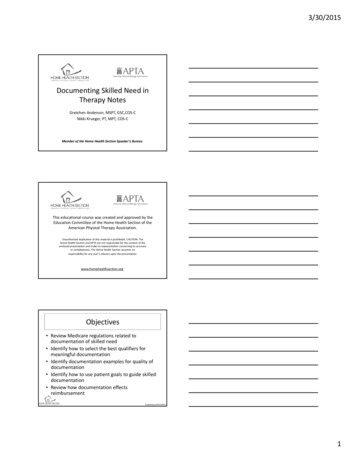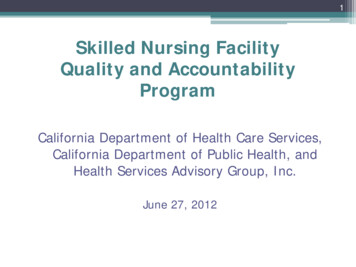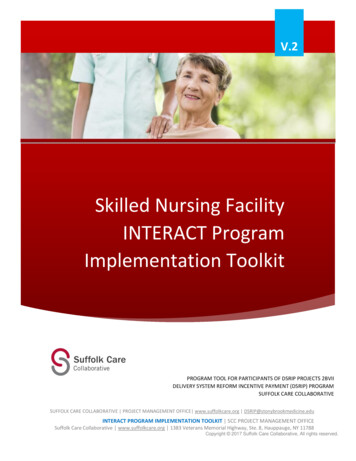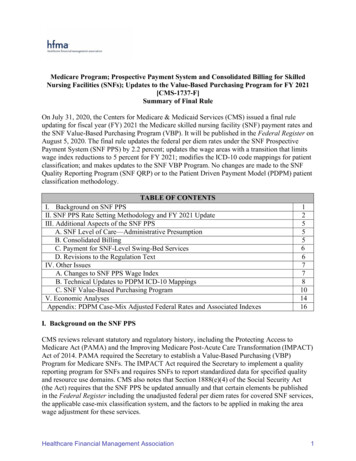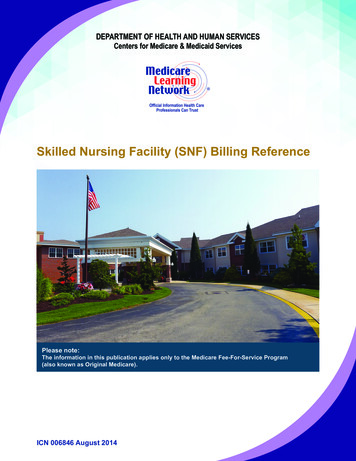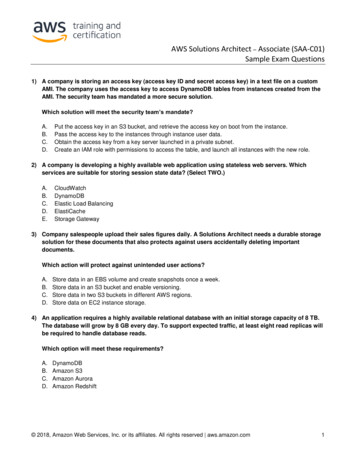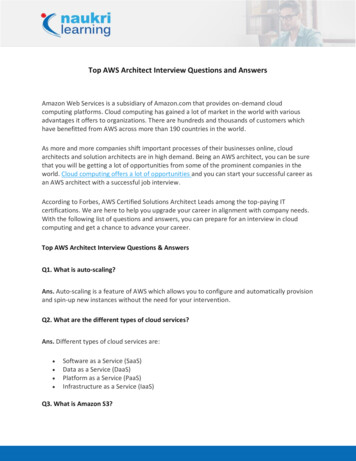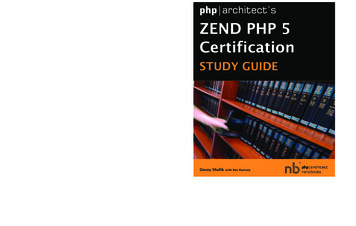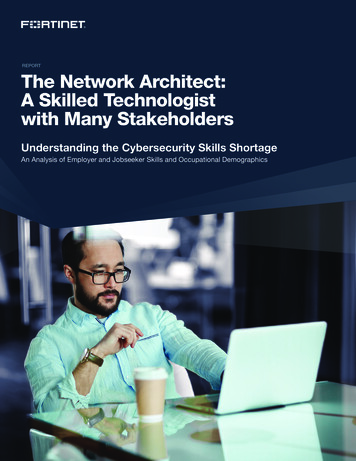
Transcription
REPORTThe Network Architect:A Skilled Technologistwith Many StakeholdersUnderstanding the Cybersecurity Skills ShortageAn Analysis of Employer and Jobseeker Skills and Occupational Demographics
Table of ContentsExecutive Summary . . . . . . . . . . . . . . . . . . . . . . . . . . . . . . . . . . . . . . . . . . . . . . . . . 3What Skills Matter to Employers: Analysis of Network Architect Job Listings . . . . 4Top Skills—Hard, Soft, and in Aggregate . . . . . . . . . . . . . . . . . . . . . . . . . . . . . 4Soft Skills Quadrants . . . . . . . . . . . . . . . . . . . . . . . . . . . . . . . . . . . . . . . . . . . . 5Examining the Candidate: Network Architect Resumes . . . . . . . . . . . . . . . . . . . . . 7Top Skills—Hard, Soft, and in Aggregate . . . . . . . . . . . . . . . . . . . . . . . . . . . . . 7Soft Skills Quadrants . . . . . . . . . . . . . . . . . . . . . . . . . . . . . . . . . . . . . . . . . . . . . 7Analyzing the Gaps Between Employers and Network Architect Jobseekers . . . . 8Hard Skills Deviations . . . . . . . . . . . . . . . . . . . . . . . . . . . . . . . . . . . . . . . . . . . . 8Soft Skills Deviations . . . . . . . . . . . . . . . . . . . . . . . . . . . . . . . . . . . . . . . . . . . . . 9Education and Certification . . . . . . . . . . . . . . . . . . . . . . . . . . . . . . . . . . . . . . . . . 10Career Tenure and Job-Hopping . . . . . . . . . . . . . . . . . . . . . . . . . . . . . . . . . . . . . 10Gender Gap . . . . . . . . . . . . . . . . . . . . . . . . . . . . . . . . . . . . . . . . . . . . . . . . . . . . . 10Concluding Thoughts . . . . . . . . . . . . . . . . . . . . . . . . . . . . . . . . . . . . . . . . . . . . . . 11References . . . . . . . . . . . . . . . . . . . . . . . . . . . . . . . . . . . . . . . . . . . . . . . . . . . . . . 112
REPORT The Network Architect: A Skilled Technologist with Many StakeholdersExecutive SummaryThis report is a part of a series that appraises various network and cybersecurityoccupations using natural language processing (NLP).1 This particular studyexamines the role of network architect from the vantage point of both employersand jobseekers. Findings show that employers seek skilled technologists with abroad mix of skills, and jobseekers tend to present themselves as more tacticalthan strategic.Core takeaways from the analysis include:Employersemphasize soft skills somewhat less than hard skills in job ads fornetwork architects, with 7 of the 20 most-cited skills identified as soft skills. The soft skillof communications is the most-cited skill, found in 98% of employer postings.nnEmployersskills referenced in job ads tend to be tactical rather than strategic in nature,such as routing, switching, and documentation. But there are enough exceptionsto indicate that employers are looking for candidates equally comfortable with thestrategic and the tactical.nnHardthe network architect is not a cybersecurity role, security architecture isreferenced on 68% of job ads, reflecting the increasing importance of security innetwork design.nnAlthoughskills cited by employers are relatively balanced across the four quadrants, withsomewhat fewer skills in the Personal Characteristics Quadrant.nnSoftsignificant subset of job listings cite many more soft skills than the median,perhaps reflecting a corporate culture or HR processes more geared toward these moresubjective skills.nnAJobseekersfor candidates seeking network architect roles include many more hard skillsthan employers. While design is the most commonly cited skill by jobseekers and canbe interpreted as a strategic skill, virtually all the other commonly referenced hard skills aretactical in nature.nnResumesAbout This SeriesThis report series is based onan analysis of thousands of jobads and resumes using naturallanguage processing (NLP) tohighlight skill-set gaps (includinghard and soft skills), educationalattainment and certifications,average career tenure, and genderbreakdown. The goal is to provideactionable insights for hiringmanagers and executives to helpthem optimize their recruiting andbuild the best networking andcybersecurity teams possible.Network architect roles areincreasingly important in manyorganizations in an era of rapidchange. For more than a decade,infrastructure, applications, anddata have steadily moved into thecloud and enterprise networkinghas become increasingly relianton the public internet. That trendmay now be reversing itself, withcyber-physical systems and thevast amounts of data they generatenecessitating more processing atthe edge of the network.2 Thesechanges often must be madequickly,3 and the network architectis intimately involved in their design.cite nearly as many soft skills as employers, and skills on resumes arespread similarly across the quadrants compared with job ads.nnApplicantsthe reasonable number of soft skills found on resumes, the huge number of tactical hard skills cited may result in an overallself-presentation that is overly tactical for an advanced individual contributor role.nnDespiteComparison of Employers vs. Jobseekerslarge number of hard skills cited on resumes means that the biggest disparities between resumes and job ads are tactical hardskills overemphasized by jobseekers. The largest disparity is with installation.nnThennAfew hard skills were underemphasized by candidates, most notably best practices and working knowledge.communications is the most-cited soft skill for both employers and jobseekers, its lower prevalence on resumes makes itthe biggest deviation among soft skills. Other soft skills underemphasized by applicants include mentoring and teamwork in theLeadership Quadrant.nnWhileoveremphasize soft skills in several quadrants, including scheduling, troubleshooting, planning, consultation,and evaluation.nnCandidates3
REPORT The Network Architect: A Skilled Technologist with Many StakeholdersDemographicsbachelor’s degree is the consensus educational level for employers and jobseekers,with both averaging approximately one degree. Jobseekers list more certifications thanemployers, likely in hopes of citing the specific certification requested on a job ad.nnAtypically had two jobs in the past five years, and some have remained inthe same job for many years. Overall, the rate of job-hopping for network architects isslightly lower than average among the occupations we surveyed.nnJobseekers4% of the resumes we studied belong to women, the third-lowest percentageamong occupations we surveyed. Fortunately, network architect job ads were more genderbalanced in terms of terminology used than with any other occupation we surveyed.nnJustThis report covers the professional who designs new and updated data networks for anorganization. The positions we surveyed all included “network” and “architect” in the jobtitle—sometimes in combination with a function like “security” or a portion of the network like“cloud.” All in all, network architects are in high demand as networks become more complexand the amount of data that moves through them increases exponentially. In fact, networkarchitects are among the highest-paid IT staffers outside of management and comparablewith security architects.5“The main trend here is blurringof the lines between the varioustraditional enterprise networkfiefdoms. Increasingly, anon-premises data-center networkhas to extend to a public cloud, abranch, or a corporate campus.”4We identified hundreds of distinct skills in the network architect resumes and job listings we analyzed. The median job listing included 43unique skills, while the median resume referenced 82 unique skills. Interestingly, resumes show a larger disparity in the number of skillsmentioned than job listings—ranging from fewer than 10 skills to more than 180. The middle 50% of resumes ranged from 50 to 105 skills.All of these numbers are higher than any of the other occupations we surveyed.What Skills Matter to Employers: Analysis of Network Architect Job ListingsBy far the most-cited skill on network architect job listings is the soft skill of communications (Figure 1), found on 98% of job ads weanalyzed. At first glance, this could seem counterintuitive for such a technical role. However, IT networks have many stakeholders andnetwork changes can be disruptive to business, making clear and concise communication paramount to the role. Less surprising is theclear second on the list: design (88%). Overall, 7 of the 20 most-cited skills are soft skills, which is near the median in the occupations wesurveyed. Interestingly, only two of these soft skills appear in the top 10.Top Skills—Hard, Soft, and in AggregateA few of the most commonly cited hard skills are more strategic in nature: design, security architecture, best practices. However, manyof them are more tactical and technical, such as routing, switching, implementation, and firewall. This may suggest that employers arelooking for candidates who are equally comfortable in the strategic and tactical roles. Network architects must exist “in the weeds” whiledesigning the details of an IT network. At the same time, they must engage with executives and other leaders at their level.It is interesting that security architecture is cited on more than two-thirds (68%) of job listings, given that the network architect is nottechnically a cybersecurity position. The need to make security a part of the underlying design of a network, rather than an add-on, isincreasingly recognized.4
REPORT The Network Architect: A Skilled Technologist with Many StakeholdersRankTop Hard and Soft Skills CombinedTop Hard SkillsTop Soft Skills1Communications (98%)Design (88%)Communications (98%)2Design (88%)Routing (78%)Analytics (70%)3Routing (78%)Security Architecture (68%)Making Recommendations (50%)4Analytics (70%)Implementation (58%)Troubleshooting (48%)5Security Architecture (68%)Standards (58%)Planning (43%)6Implementation (58%)Switching (58%)Complexity (38%)7Standards (58%)Documentation (53%)Management (38%)8Switching (58%)Firewall (53%)Leadership (33%)9Documentation (53%)Configuration (40%)Mentoring (30%)10Firewall (53%)Best Practices (38%)Participation (30%)11Making Recommendations (50%)Cloud (35%)Problem Solving (30%)12Troubleshooting (48%)Hardware (35%)Partnership (30%)13Planning (43%)Network Operations Center (35%)Collaboration (28%)14Configuration (40%)Organization (35%)Writing (25%)15Best Practices (38%)Wireless (35%)Research (20%)16Complexity (38%)Cisco (33%)Vision (20%)17Management (38%)Networks (33%)Drive (18%)18Cloud (35%)TCP (30%)Evaluation (18%)19Hardware (35%)Data Center (30%)Acting as a Liaison (18%)20Network Operations Center (35%)Software (30%)Prioritization (18%)Figure 1: Top 20 hard and soft skills for employers.Soft Skills QuadrantsSoft skills can be better understood when they are divided into four quadrants (see Figure 2). Besides communications (in theCommunications/Interpersonal Quadrant), soft skills among the top 20 overall skills are commensurate with a senior technical position:analytics, making recommendations, troubleshooting, and planning. It is interesting that three of these four are in the AnalyticalQuadrant. Planning, cited on 43% of job listings, is the most-cited skill in the Leadership Quadrant.Despite the prominence of the Analytical Quadrant among the most-cited soft skills, job ads are fairly balanced in the mix of soft skills theyrefer to, indicating employers look at a wide range of soft skills—perhaps customized to the position and corporate culture. The medianjob listing had three skills each in the Leadership, Analytical, and Communications/Interpersonal Quadrants—and two skills in the PersonalCharacteristics Quadrant. This suggests that employers seek a qualified technologist who is well-rounded as an individual.It should be noted that some job listings emphasize soft skills more than others, and a significant subset cite significantly more than themedian number of soft skills in each quadrant. For example, one-quarter of resumes cited between 5 and 8 Analytical Quadrant skills whileone outlier mentioned 10. The result is that the average number of skills cited for each quadrant is higher than the median. Recruitingpractices often align with other aspects of corporate culture, and it seems that a nontrivial number of them emphasize more soft skills as apart of HR department practices or other aspects of organizational identity.5
REPORT The Network Architect: A Skilled Technologist with Many StakeholdersAnalyticalLeadership3.6 Average Skills Per Job Ad93% Occurrence in Job Ads3.2 Average Skills Per Job Ad88% Occurrence in Job Ads4-50-2Number ofskills in job ads0-34 Number ofskills in job ads36 Personal CharacteristicsCommunications/Interpersonal2.5 Average Skills Per Job Ad85% Occurrence in Job Ads3.4 Average Skills Per Job Ad98% Occurrence in Job Ads43Number ofskills in job ads0-2Number ofskills in job ads0-34 5 Figure 2: Job ad soft skills quadrant matrix: network architect.The two most-cited Personal Characteristics Quadrant skills are mentioned on only 18% of job ads—drive and prioritization—tied for17th among the most-cited soft skills. The top 20 skills on that list include:nn7in Analytical (analytics, making recommendations, troubleshooting, complexity, problem solving, research, evaluation)nn6in Leadership (planning, management, leadership, mentoring, partnership, vision)nn5in Communications/Interpersonal (communications, participa
What Skills Matter to Employers: Analysis of Network Architect Job Listings By far the most-cited skill on network architect job listings is the soft skill of communications (Figure 1), found on 98% of job ads we analyzed. At first glance, this could seem counterintuitive for such a technical role. However, IT networks have many stakeholders and
